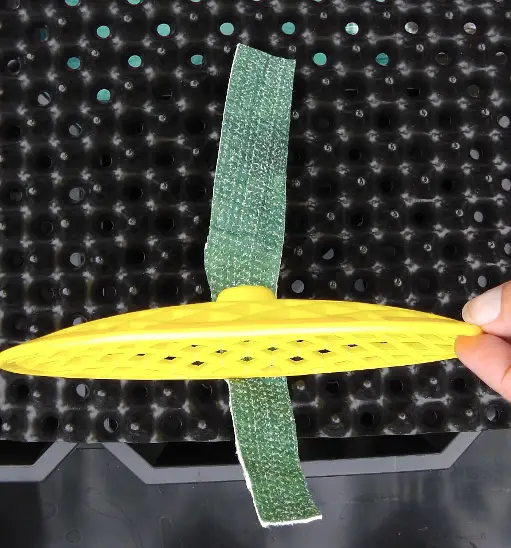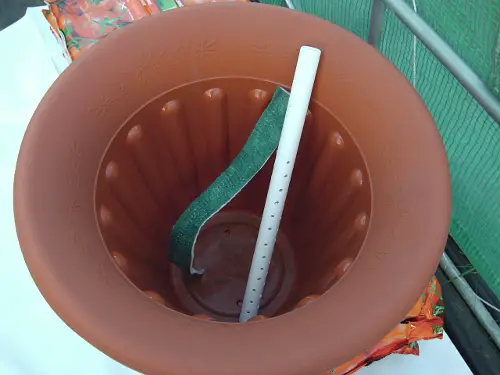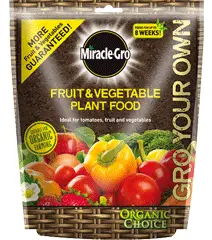It’s May at last and at the end of this month, plants can stay outdoors – frost free. Before they reach their final home, it’s worth considering how we are going to water and feed tomatoes in containers.
Some of my plants are desperate to be potted on, so the final large container will be very welcome.
How To Water and Feed Tomatoes in Containers
Planning for watering and feeding
Air pots need an additional wick of capillary matting added if they are watered from below in trays (think holiday).

Standard large pots that are deep (more than 9 inches) would do better with an air pipe. Also, if a pot or container is very tall it’s best to water it from above (from time to time) owing to the limits of capillary action. An alternative is to use a capillary wick.

All growing media is better with perlite added – roots need oxygen and so do soil microbes (bacteria and fungi are very important for organic growing).
Feeding in containers
The chemical nutrient approach
Using the nutrients already available in the new soil, be it a grow bag or multi-purpose compost, then on to a Tomorite type feed when plants begin to flower and fruit.
This is probably the most popular way to feed tomato plants but it’s a bit hit and miss, depending on all sorts of growing conditions.
Bio Nutrients
New soil with extra organic feed added, such as fish, blood and bone – only 75p at wilko’s, then organics for flowering and fruiting.
The challenge here is to find organic nutrients that promote flowering and fruiting – high in potash. There are products on the market for feeding plants that are fruiting such as:

Tomato taste and nutrients
Last season, the weather was very good compared to the previous five or six seasons, and many gardeners in the UK had a huge crop of tomatoes.
The one area in which I was disappointed was the taste of some varieties.
Of course my home grown tomatoes always taste better than shop bought toms, but the quest for excellence should also include learning ways to maximise the natural flavour of each variety – quality as well as quantity.
This is where the chemical versus the bio approach is relevant.
Over feeding some mineral salts, namely nitrogen and some of the trace elements (when using chemical feeds) can reduce the flavour of tomatoes.
The beauty of the organic approach is that it is led by soil microbes. It is they who turn organic matter into plant food, and importantly, at a rate that is best for plant growth and tomato taste.
So why should organic tomatoes taste better than those fed with chemical based nutrients? This is a controversial subject!
Because plants receive the nutrients that friendly bacteria have made and not the ones that where made at the chemical factory!
It’s about balance and strength
Plant roots in conjunction with soil microbes form a relationship in organic growing that produces the right balance and strength of nutrients for the plant. This makes it difficult to over feed and to give the wrong balance of nutrients.
Flavour
It is both the wrong nutrient strength and nutrient balance that reduced the flavour of my toms last season – although I did have an amazing amount of tomatoes!
This season I’m testing a number of organic options and comparing them with the traditional “new compost then tomorite” approach.
I expect both methods to produce plenty of tomatoes but ultimately – it’s the taste that counts.
Conclusion
It is much easier to feed the right amount of nutrients using organic methods because the friendly microbes in the soil are involved.
It’s always good to know what you think … please leave a comment below if you would like to!
Regards,
Nick
Plants still need to be kept under cover at night – until the end of May in the UK to protect them from frost.
Watering in the morning is best so that plants won’t sit in wet cold soil overnight.
One of the best supplementary feeds is liquid seaweed. It can be used as a foliar spray and plants love it!


Gilles Chatelain
Can I feed my tomato plants in a self-watering wicking pot with water soluble fertilizer mixed with water to refill?
Nick
Yes that’s fine.
Brian James
Sorry, I hit the button before I’d added a polite end to my query, so…
Many thanks for any advice!
Brian James
Hi,
I’ve tried the capillary matting wick [top of the page] with air pots, but also watering from the top. I’ve certainly not seen the dramatic root growth you’re supposed to get with these pots and am wondering whether I’m over-watering. Would the wick be enough if the water tray is always kept topped up? I’m sure I recall from decades ago the advice to water from below and feed from above; is there any merit in that?
BTW, last year, due to both lack of space and the cost of compost, I put two tomato plants [good ol’ Alicante] in an air pot recommended for one and saw no difference in quality or quantity of the crop, other than that the previous year’s had an incredibly tough skin, but that’s probably down to something else.
One final question, if they’ve used lots of vermiculite and/or perlite in the mix, what do people do with the compost at the end of the season? Compost heap, mulch, bin it, re-use it for something less demanding – seed compost perhaps, put a percentage back into the next season’s mix … ? I hate throwing anything away and it’s not cheap. With the cost of perlite, compost, these fancy pots, fert, and everything else, I dread to think what each tomato actually costs!
Nick
Hi Brian, yes, watering from below in trays is the best way, with or without a wick. If you don’t add feed to the tray then watering from above is good as long as the water/feed is absorbed and doesn’t poor out the holes in the air pot. The wick is helpful because of the gap in the air pot – between the base and the water level. Eventually, the roots grow down into the tray and are able to absorb water at a faster rate when fruiting.
Tough skin is usually down to temperature fluctuations as the tomatoes are expanding – they grow thicker skins to cope.
I re-use old compost by planting pots or grow bags above. Plants are established in new compost then are able to grow down into the old stuff.
Regards.
Nick
Steve H
Hi Nick. Many thanks for a wonderful website!
I have taken to feeding my outdoor tomato plants (in growbags) at 1/4 strength every time I water in recent years. What are your thoughts on this method?
I am seeming to get quite thick skins on the plentiful tomatoes, but I had put this down to our recent UK summers (wet, lack of sunlight). Am I missing that it could be the feeding? I do also flush through with clean water every fortnight or so to try and cleanse any potential nutrient build up. Suffered terrible blight well before the end of the season last year 🙁
Thanks in advance
Steve 🙂
Nick
Hi Steve,
I usually find that thick skins are a result of temperature fluctuation as the toms are swelling but you could try feeding a couple of plants the regular feeding instruction on the container and compare the results.
At least half of the varieties I grow these days are blight resistant. I have suffered with blight too in the past given the wet spells we often get in July/August.
Cheers,
Nick
Geraldine
Hi Nick,
I’ve been reading your website quite a lot lately and wanted to thank you for putting out so much valuable information on this topic. I am new at growing tomatoes, or any other kind of vegetable/herb for that matter. So, even though I have been learning a lot about the process, I still have a bunch of questions. I bough a tumbler tomato plant and transplanted it about two days ago. I used a 10” pot and filled it with a mix of about 50/50 soil mix and compost, plus 1 tbsp of slow-release organic fertilizer. I watered the mix of soil/compost, put the plant in, and placed a couple of tiny basil plants next to it. The day after I transplanted the plant it looked a bit tired, so I added more water and it started looking better. However, I checked it this afternoon and noticed a bunch of light yellowish spots on a few leaves, as well as a couple of leaves that were dried out. I am not sure what to do. I added a bit more water because they looked a bit dry to me? but I do not want to overwater the plant. Not sure if it’s worth mentioning, but the basil plants next to it seem to be doing pretty well. Anyways, do you have any idea what could be going on? Also, what’s the recommended amount of water/sun for this kind of tomato? – I have checked several sources and they all seem to provide dramatically different information. I’d very much appreciate your help.
Looking forward to hearing back from you!
Geraldine
Nick
Hi Geraldine, seems like you are doing everything right.
It’s best to remove the leaves or leaf branches affected. If the damage is on lower leaves, it doesn’t sound too bad, the plant will improve.
If the yellow spots are on higher leaves, the plant may have an infection.
Either way, in warm sunny weather a pint of water each day should be about right, depending on the size of plant and whether it’s fruiting or not.
For a quicker response email me at [email protected]
terry scoates
Hi Nick, please can you give me some advice, This morning I went to pot some Tomato plants into final pots, I got as far as filling the pots half way with compost and Vermiculite when I noticed the compost in the pots were full of Ants and so was the rest of the Compost in the bag.
I have put some Ant Powder into the pots and the compost bag, If I plant the Tomato plants now into the pots will they be ok or will the Ant Powder kill the plants or should I start again?.
best regards from terry
Nick
Hi Terry,
To be honest I don’t know but to be on the safe side I would start again.
Nick
Helen
Hi Nick
We have had some very unseasonal rain
Very heavy and very prolonged over night
Unfortunately I couldnt get out to protect them
I know you have mentioned that Tomatoes dont like rain
What is the best thing to do now?
Nick
Hi Helen,
They’ll be ok with just one day of rain. Let the soil dry out a bit and put them in a light airy place if they are in containers.
The combination of wet cold leaves in saturated soil is the danger.
Regards,
Nick
ray
I personally believe it does not matter if the plants are fed organically or chemically, the taste is still the same, the plant dos’nt know if it gets it food from a tin or not.
Milly Thompson
Hello. The yellow plastic wick gadget you’ve pictured in today’s newsletter.
Where can you buy one? I’ve looked everywhere.
Thanks
Nick
Hi Milly,
The wick is the green strip of capillary matting and the yellow base is the bottom of the air pot. I just buy a few metres of capillary matting and it does a lot of useful jobs.
Nick